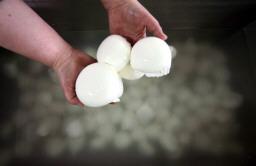Fears that mozzarella cheese may be tainted with carcinogenetic dioxins are unjustified, according to the Italian Confederation of Farmers (Cia).
According to the farmers' union it was important to keep these fears from developing into a global panic similar to the one over 'mad cow' disease,
Cia said it welcomed the checks being made by health inspectors on herds in the Naples area, where some grazing fields are believed to be contaminated by toxic waste, and urged ''the utmost caution in managing information'' about the tests.
The organization recalled that real mozzarella is subject to strict quality controls and warned that a dioxin panic ''would harm production not only in the region of Campania but also in Puglia and Lazio'', where variation of mozzarella are produced.
''We intend to protect and promote buffalo mozzarella because we are convinced of the extraordinary quality of this product and we want to avoid an unjustified commercial panic which in a very short time could provoke wide-scale unemployment and losses of millions of euros,'' Cia said.
The farmers' organization issued its statement soon after South Korea and Japan announced that they were banning imports of the Neapolitan cheese.
According to a consortium of quality mozzarella producers, the farms where the dioxins were found were only a fraction of the close to 2,000 which produce mozzarella in the Naples are
Experts have pointed out that the concentration of dioxins which have been found were not high enough to pose a health hazard.
Real mozzarella cheese has been awarded the European Union's Protected Designation of Origin (PDO) quality seal.
Mozzarella is a fresh, stringy textured cheese with porcelain-white colour, an extremely thin rind and a delicate taste. When cut, it produces a white watery fluid with the aroma of milk enzymes.
Apart from its typical round shape, it is also produced in small bite-sized shapes and plaits.
The peculiarity of the cheese is entirely due to the technology used in its traditional preparation. It is produced exclusively from whole buffalo milk and, after drawing and moulding, may also be smoked.
Buffalo milk is not for drinking and is used exclusively for making mozzarella. It is so nutritious and rich in fat and cassein that it would be indigestible over the breakfast table.
Mozzarella-making is a very fast process. The milk is brought in, curdled, then drained to eliminate the whey. After this the curd is cut into small pieces, then ground up in a sort of primitive mill.
At this point, reduced to crumbles, the curd is put into a mold and immersed in hot water, where it is stirred until it takes on a rubbery texture.
The cheesemaker kneads it with his hands, like a baker making bread, until he obtains a smooth, shiny paste, a strand of which he pulls out and lops off, forming the individual mozzarella (''mozzare'' in Italian in fact means to lop off).
These in turn are put into cold water and then to soak in brine. The cheese absorbs as much salt as is necessary and has to take on consistency.
In the end, it must not be soft and mushy when cut but fibrous and elastic, so that if poked it springs back to its original shape. Mozzarella, prepared in the evening, is ready the next morning.
Rich in calcium, high in protein and lactic flora substances, and with a high vitamin and mineral salt content, it is highly nutritional.













